Bias-Variance Trade-off だけではもう古い?
- 論文輪読用の資料です
- 近年の GPT-3 をはじめとした、巨大なパラメータ数をもつ深層学習モデルでは、伝統的な Bias-Variance Trade-off のコンセプトが必ずしもあてはまらないことが経験的に観測されており、その現象 (double descent) を研究した論文です
- slide 版は以下
DEEP DOUBLE DESCENT: WHERE BIGGER MODELS AND MORE DATA HURT
Submitted on arxiv: 2019-12-04
ICLR 2020: https://iclr.cc/virtual_2020/poster_B1g5sA4twr.html
arxiv: https://arxiv.org/abs/1912.02292
Authors: Harvard University と OpenAI (GPT モデルを作ったところ) のグループ
[補足] GTP-3 は 1750億個のパラメータを持つ巨大なモデル
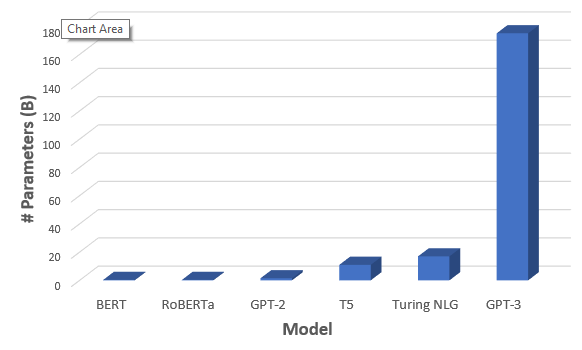
Ref: GPT-3: The New Mighty Language Model from OpenAI
どんな論文か?
- 近年の Deep Learning Model では、パラメータ数が大きいほどパフォーマンスがよくなる傾向がある
- この傾向は、古典的な Bias-Variance Trade-off の概念とは矛盾している
- トレーニングサンプル数よりもモデルの複雑さを上げることで、過学習の先に、さらにパフォーマンスが改善する現象 (Double Descent) が Deep Learning Models において広く起こることを証明した
- Double Descent を Effective Model Complexity という指標を用いることで説明した
- この論文で示される経験的な証拠は、従来の知恵を再整理し、刷新する内容であると考えられる
[補足] Bias-Variance Trade-off
The bias-variance trade-off is a fundamental concept in classical statistical learning theory (e.g., Hastie et al. (2005)).
- 機械学習の教科書に登場する伝統的、古典的な内容
- underfitting (high bias) と overfitting (high variance) のバランスを取れたモデルを作るべき
- 正則化項をつけて overfitting を起こりにくくするなどの工夫がされてきた


Diagnosing Bias vs. Variance – Deep Learning Garden
伝統的に知られているコンセプトと近年 DL model に見られる現象の乖離
- 伝統的な Bias–Variance Trade-off の考えかたでは、モデルを複雑にするほどパフォーマンスは悪くなる(過学習)と考えられてきた
- つまり、「より大きなモデルは、より悪いモデルとなる」と理解されてきた
“larger models are worse.”
- modern neural networks では、そのような現象は観測されていない
- この界隈の practitioners の間で上記のことから「より大きなモデルは、より良いモデルとなる」ということが知られてきた
"larger models are better"
- トレーニング時間がテストエラーに与える影響も議論されてきた
- “early stopping” でテストエラーを小さく場合もあるし、それを使わずにトレーニングエラーが 0 になるまで学習する場合にパフォーマンスがよくなる場合もある
- 最終的な、classical statisticians と deep learning practitioners の共通認識としては、「より多くのデータを使うべし」ということであった
“more data is always better”
結果の概要 (詳細は後述)
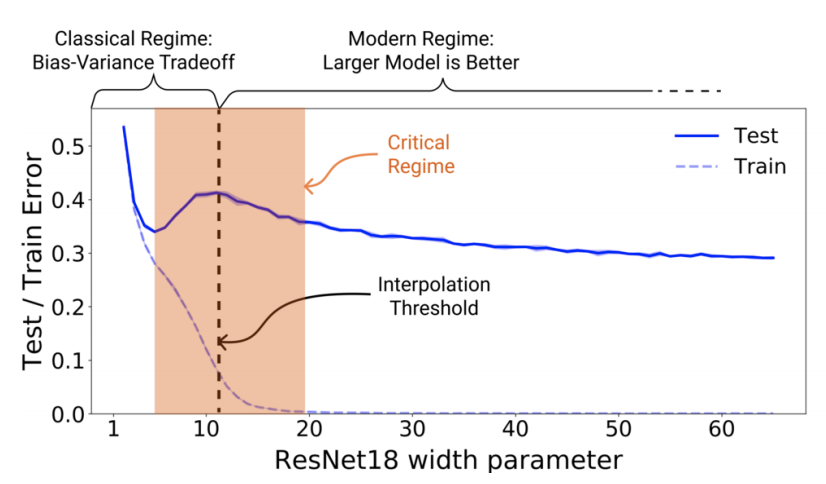
Figure 1 Left: Train and test error as a function of model size, for ResNet18s of varying width on CIFAR-10 with 15% label noise.
- double descent が観測されている
- パラメータ数を interpolation threshold (後述) より大きくするとテストエラーは低くなる
- interpolation threshold より左側は、古典的な bias-variance trade-off の concept に従う挙動をする
- interpolation threshold より右側は、モダンな Deep Learning モデルが示すようにパラメータ数が大きいほど、パフォーマンスが良くなる挙動を示す
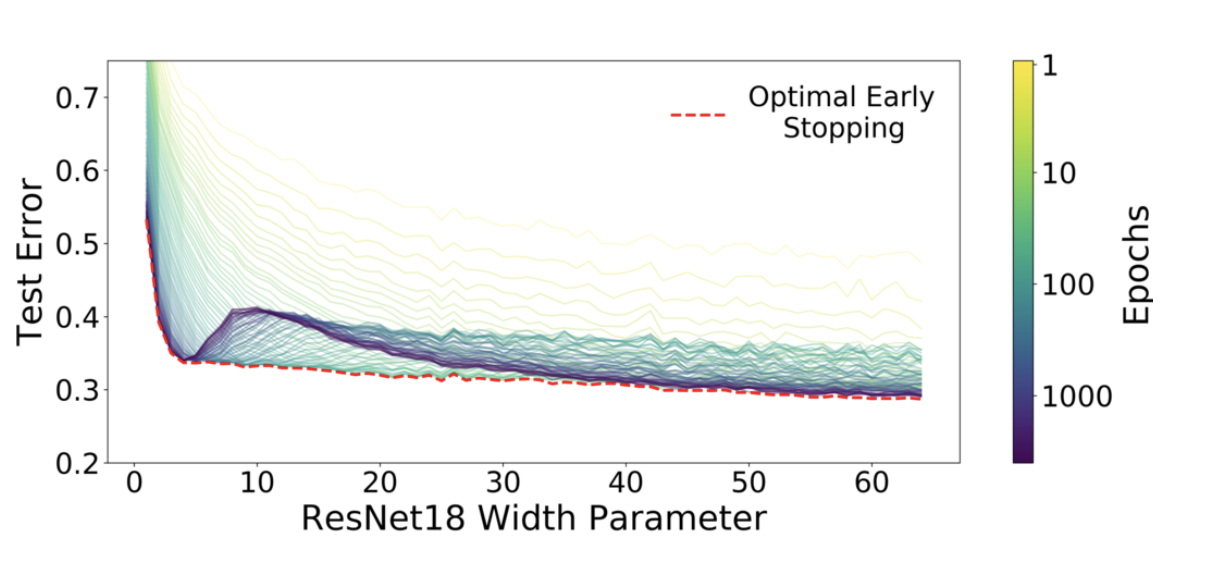
Figure 1 Right: Test error, shown for varying train epochs. All models
trained using Adam for 4K epochs. The largest model (width 64) corresponds to standard ResNet18.
- early stopping は interpolation threshold 付近の Critical Regeme と呼ばれる領域でのみ有効で、その他の領域ではあまり効果がない
- Critical Regeme (interpolation thredhold 付近) では、epoch 数が大きいほどパフォーマンスが悪くなるが、それ以外の領域では、epoch 数が大きいほど良くなる
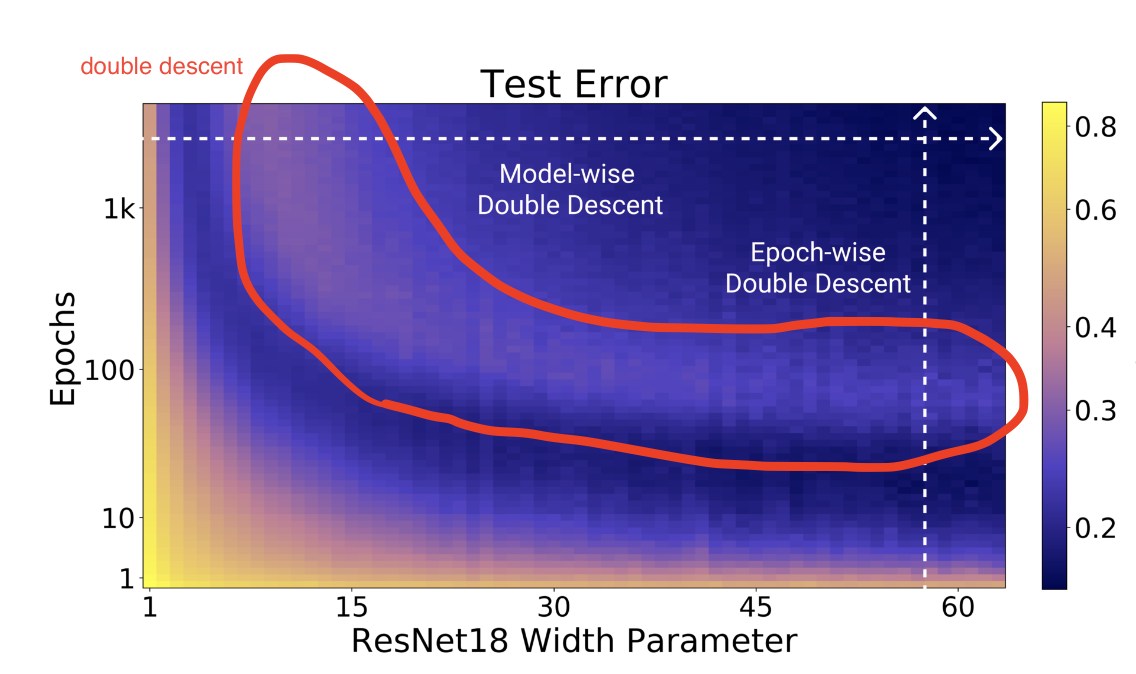
Figure 2 Left: Test error as a function of model size and train epochs. The horizontal line corresponds to model-wise double descent–varying model size while training for as long as possible. The vertical line corresponds to epoch-wise double descent, with test error undergoing double-descent as train time increases.
- パラメータ数を大きくすることで Model-wise double descent を観測
- epoch 数を大きくすることで Epoch-wise double descent を観測
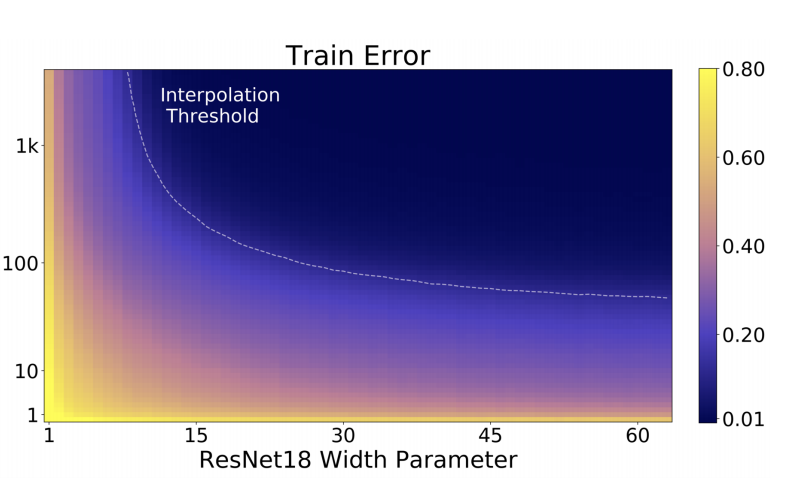
- トレーニングエラーは単調減少
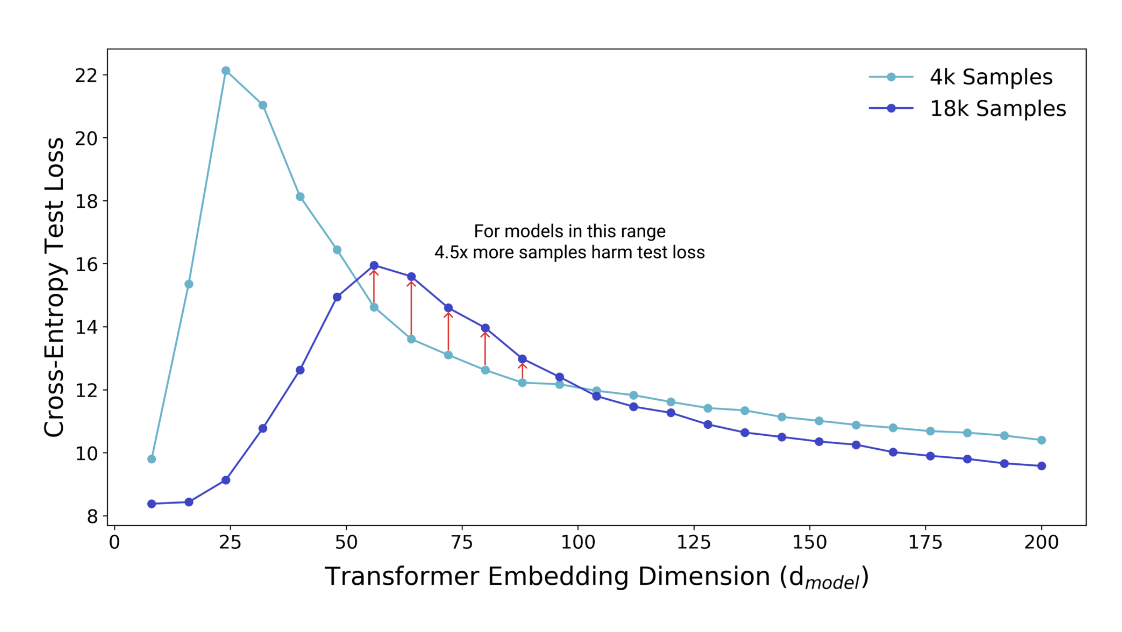
Figure 3: Test loss (per-token perplexity) as a function of Transformer model size (embedding dimension d_model) on language translation (IWSLT‘14 German-to-English). The curve for 18k samples is generally lower than the one for 4k samples, but also shifted to the right, since fitting 18k samples requires a larger model. Thus, for some models, the performance for 18k samples is worse than for 4k samples.
- 4,000 samples と 18,000 samples で比較
- 基本的にはサンプル数が大きい方がテストエラーは小さい
- 18k samples では全体的に右にシフトしているが、より大きなサンプル数に fitting するためにはより多くのパラメータが必要なため
- 一部のモデルサイズ領域 (赤線矢印の箇所) ではサンプル数が少ないほうがよいパフォーマンスを示す
実験の詳細
様々な条件で実験を行った結果、それぞれに特徴的な double descent の挙動が観測された。
その詳細に関して、以下では説明する。
手法
- Architectures
- ResNets
- a family of ResNet18s
- layer widths [k; 2k; 4k; 8k] for varying k
- the standard ResNet18 corresponds to k = 64
- Standard CNNs
- a simple family of 5-layer CNNs, with 4 convolutional layers of widths [k; 2k; 4k; 8k] for varying k, and a fully-connected layer
- Transformers
- the 6 layer encoder-decoder
- modifying the embedding dimension
d_{model}
- ResNets
- Datasets
- CIFAR-10, CIFAR-100, IWSLT'14 de-en, WMT'14 en-fr
- Optimizers
- SGD, Adam
- その他
- data augmentation
- label noise
- early stopping
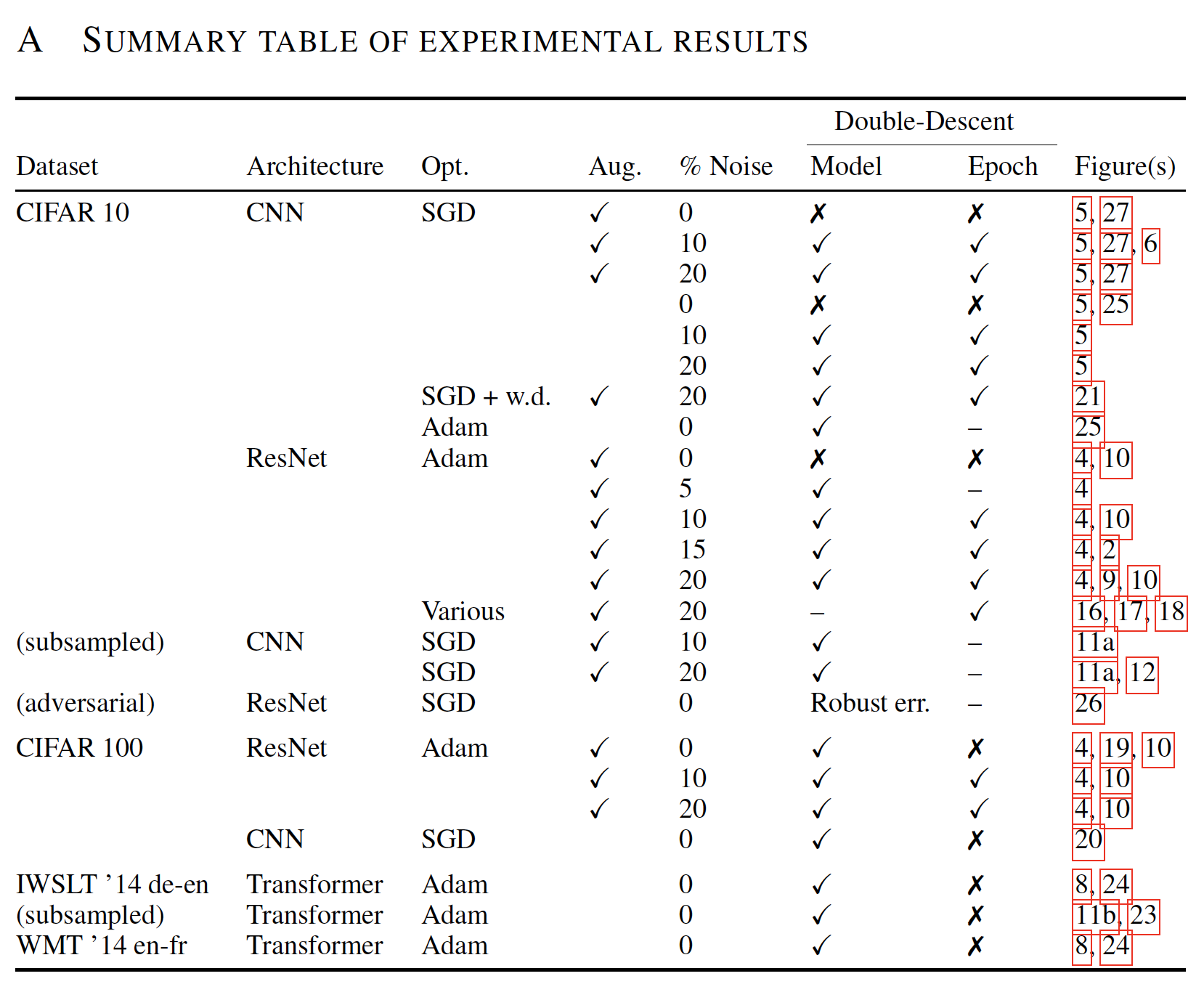
より詳細が知りたい場合は、論文の Appendix B を参照
Effective Model Complexity (EMC)

We define the effective model complexity of T (w.r.t. distribution D) to be the maximum number of samples n on which T achieves on average ≈ 0 training error.
- EMC は、トレーニング手順(モデルパラメータ数、epoch 数、その他)に依存
- EMC = トレーニングエラーが
\epsilon = 0.1 - 現状、
\epsilon = 0.1
Interpolation Threshold (EMC = n)
EMC と Interpolation threshold に関しては下図をみるとイメージしやすい
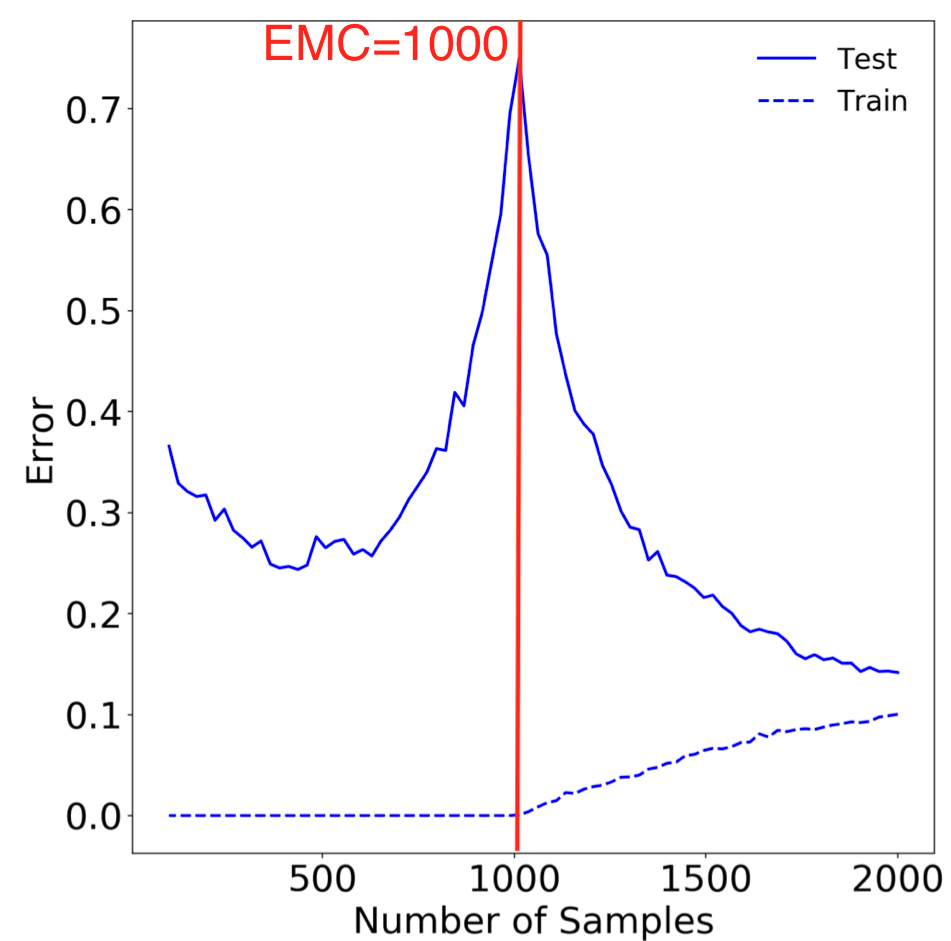
Figure 15: Sample-wise double-descent slice for Random Fourier Features on the Fashion MNIST dataset. In this figure the embedding dimension (number of random features) is 1000.
Our experiments suggest that there is a critical interval around the interpolation threshold when EMC = n: below and above this interval increasing complexity helps performance, while within this interval it may hurt performance.
MODEL-WISE DOUBLE DESCENT
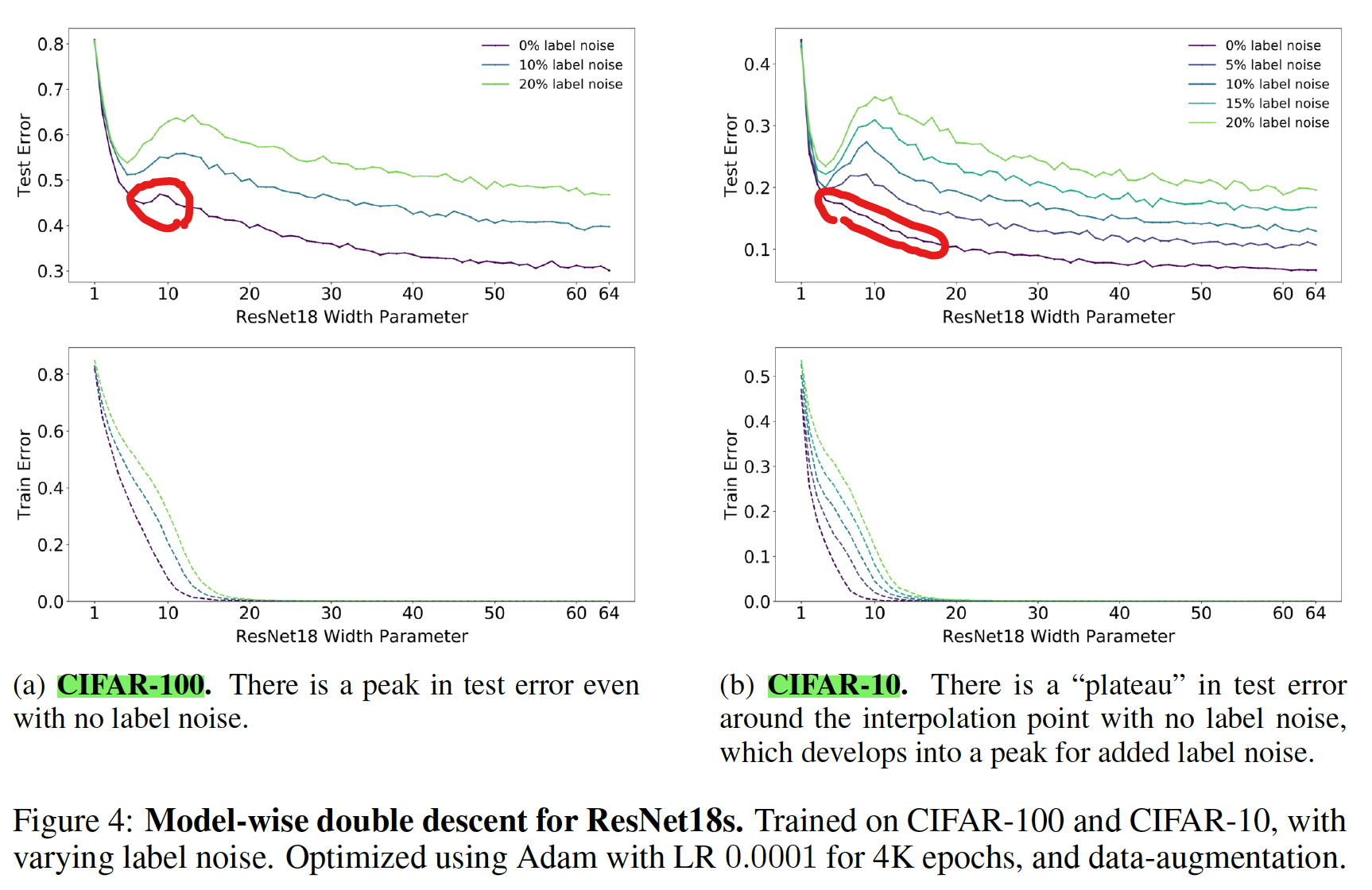
- ResNet18s の Width Parameter (モデルサイズ) を大きくしていくと double descent が観測された
- CIFAR-10 の場合、誤ラベル (ノイズ) を導入しなかった場合、double descent は観測されなかったが、CIFAR-100 の場合にはノイズなしでも double descent が観測された
- ノイズが double descent の出現に強く影響を与えている
[補足] Plateau
There is a “plateau” in test error around the interpolation point with no label noise

Plataue: A comparatively stable level in something that varies.
Plateau meaning and definition
Effect of Data Augmentation
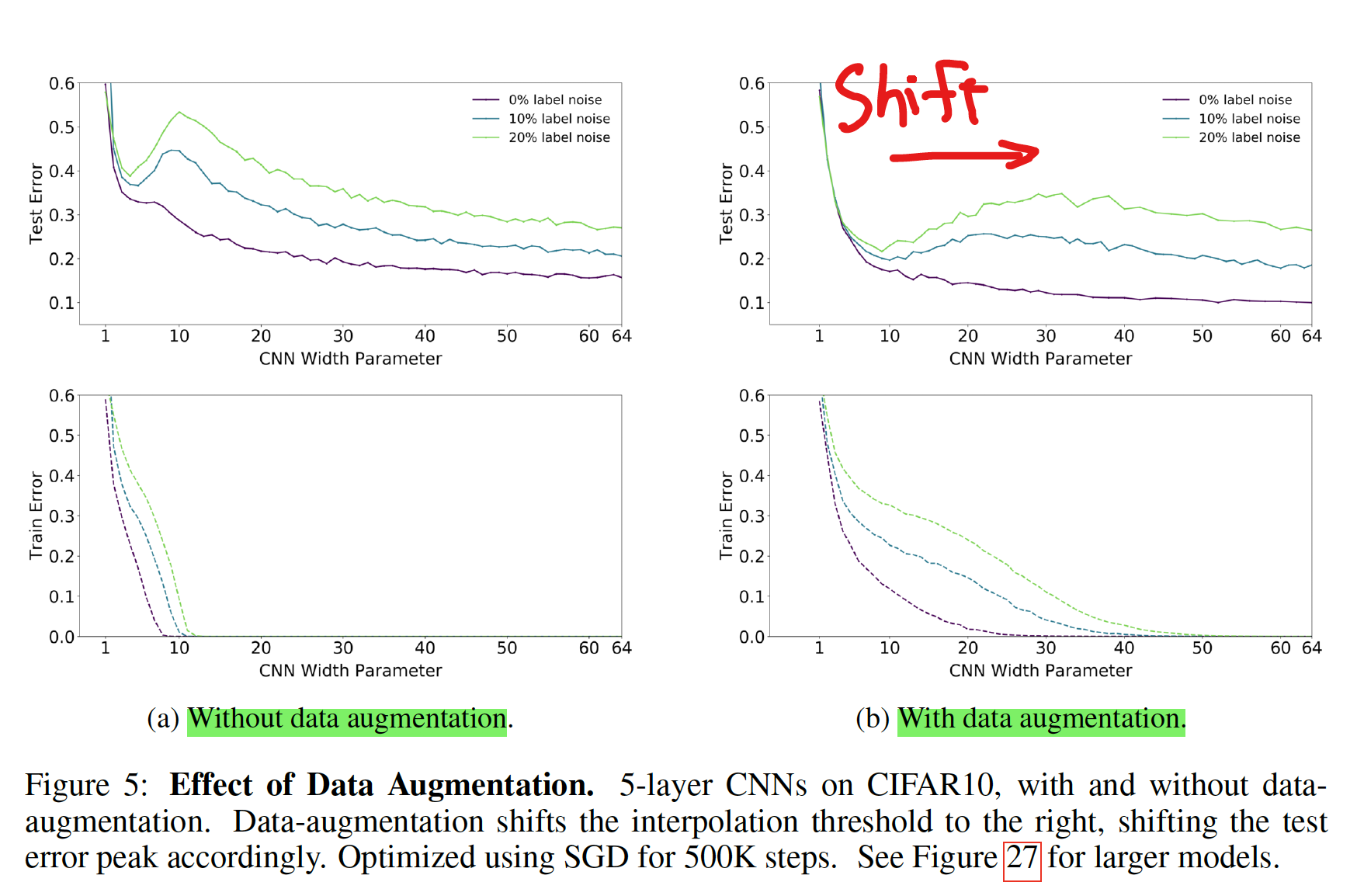
- data augmentation あり、なしで比較
- data augmentation を行うことにより、peak が右にシフトした
- 論文中では議論はないが、data augmentation で interpolation threshold を shift させるのは、augmentation で training sample 数が増えているためか
Effects of optimizer and noise
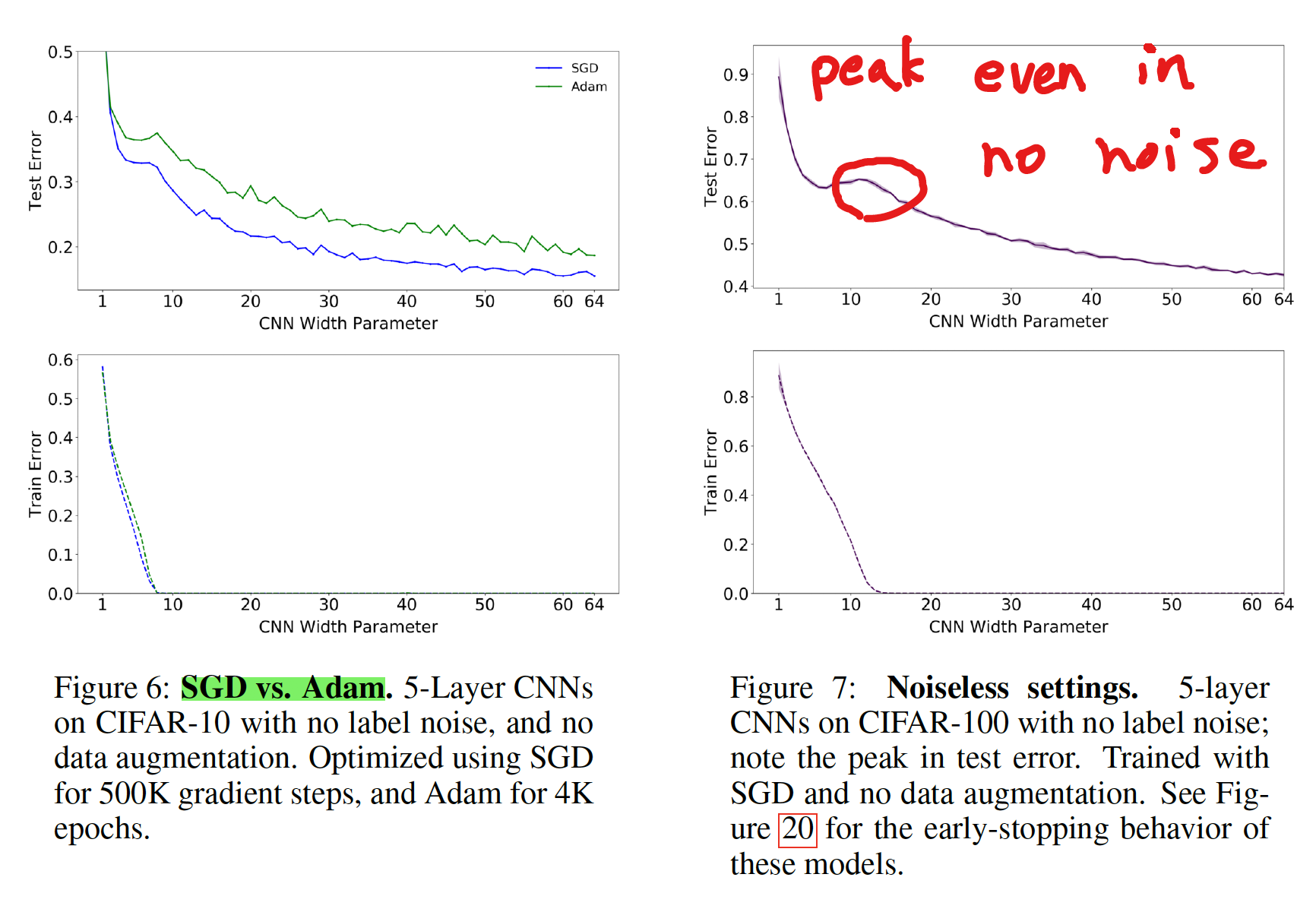
- Adam より SGD の方が、テストエラーが低くなる
- 論文中、理由に関しては議論はされていない
- ノイズがない場合でも、double descent のピークが出現するケースが有る
Transformers モデルにおける Dataset の違いが与える影響

- より大きいデータセット (En-Fr) を使うと、ピークが右にシフトする
EPOCH-WISE DOUBLE DESCENT
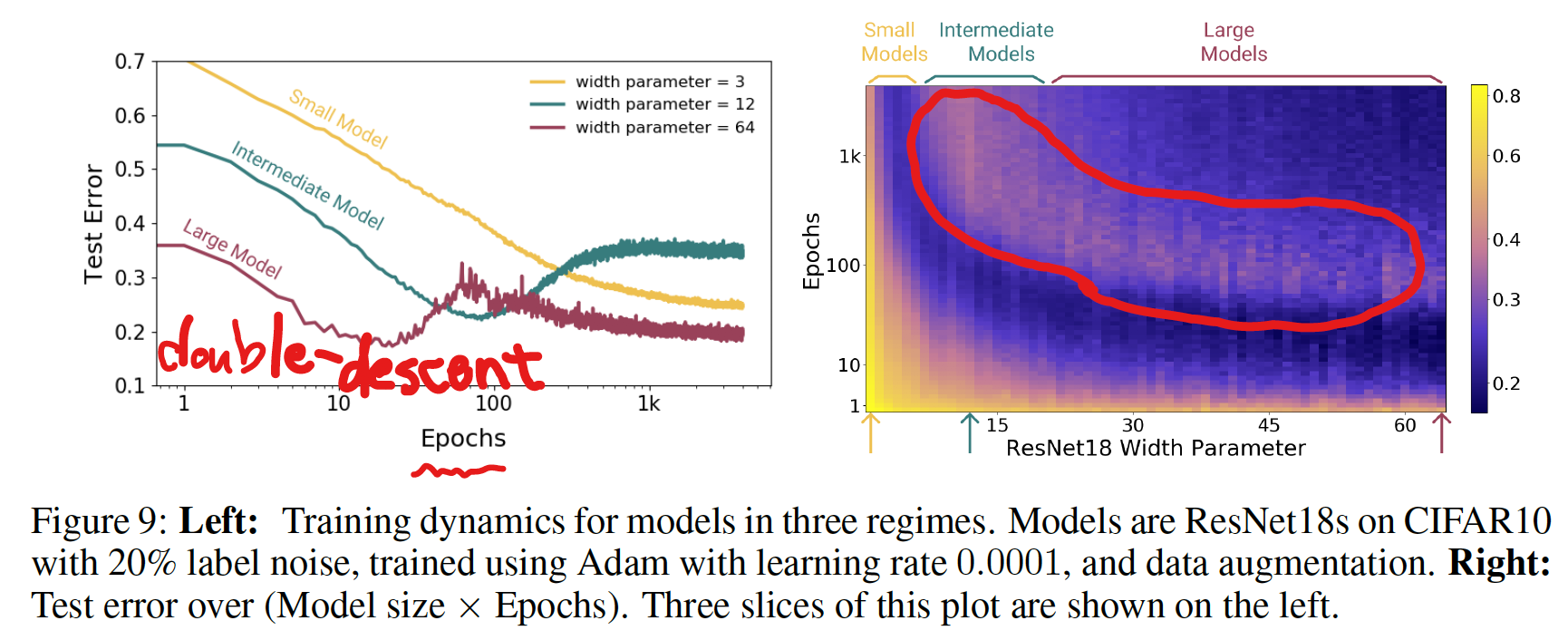
- モデルサイズは固定し、epoch 数を変えることでも double descent が起こる
ラベルノイズを載せたときの epoch-wise double descent
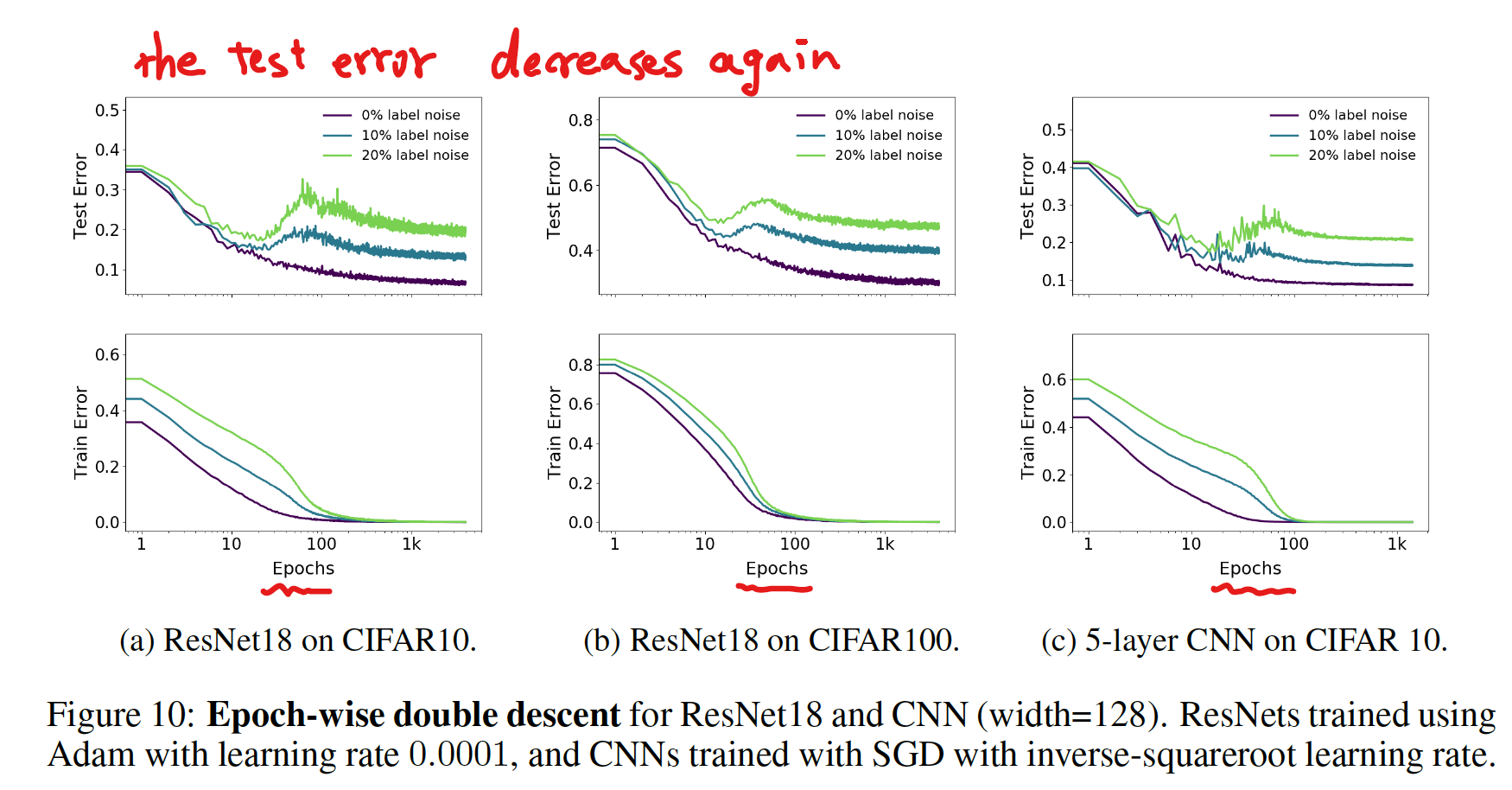
- label noise がない場合は double descent は見られなかった
- label noise がある場合は double descent が見られた
SAMPLE-WISE NON-MONOTONICITY
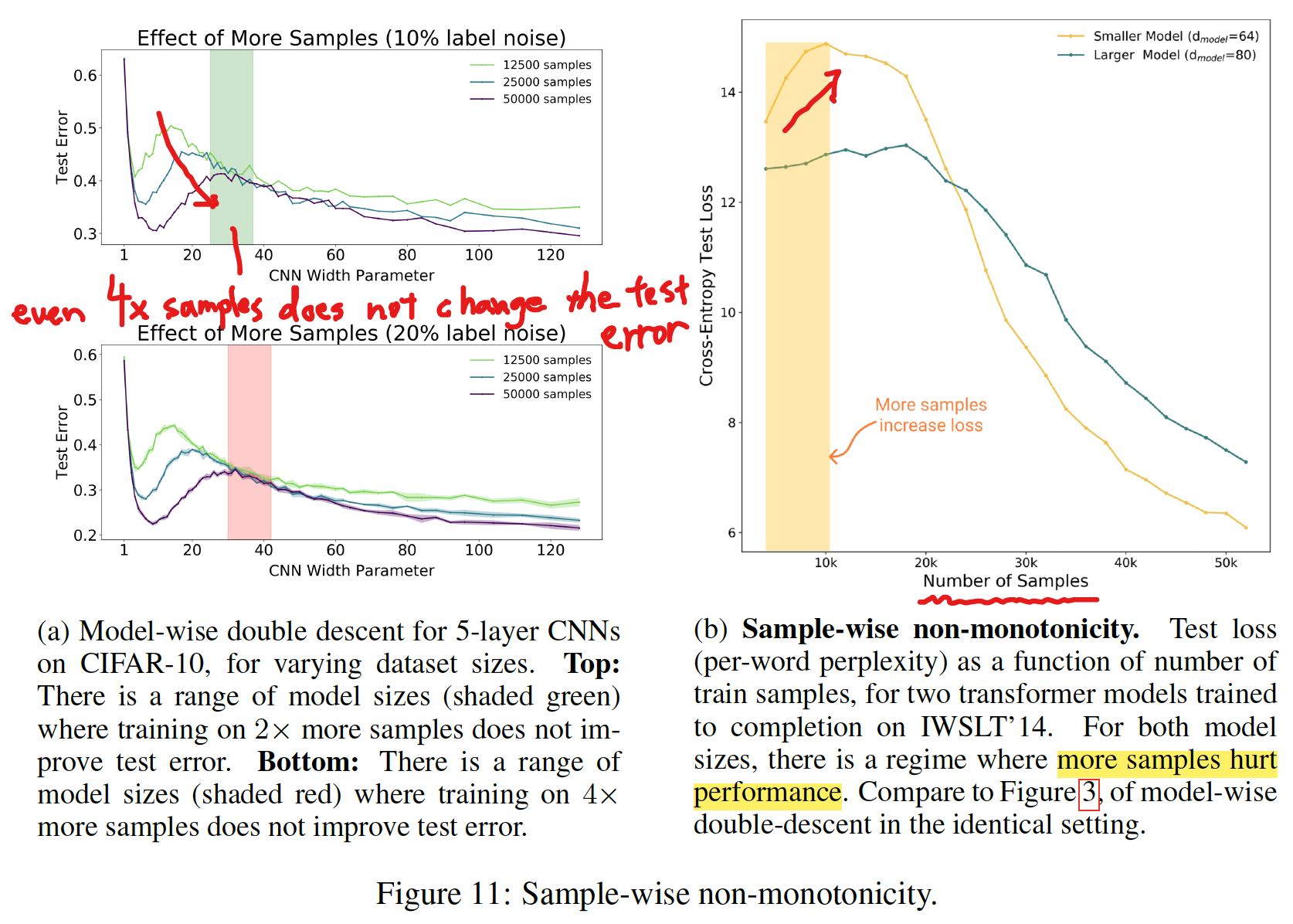
- トレーニングサンプルの数を変えたときの変化
- サンプル数が大きいほどテストエラーは低くなる傾向がある
- 左図 (a) の網掛け領域では、サンプル数がパフォーマンスに影響を与えていない
- 右図 (b) のように、サンプル数が比較的小さい領域では、サンプル数が大きいほどパフォーマンスが悪くなっている
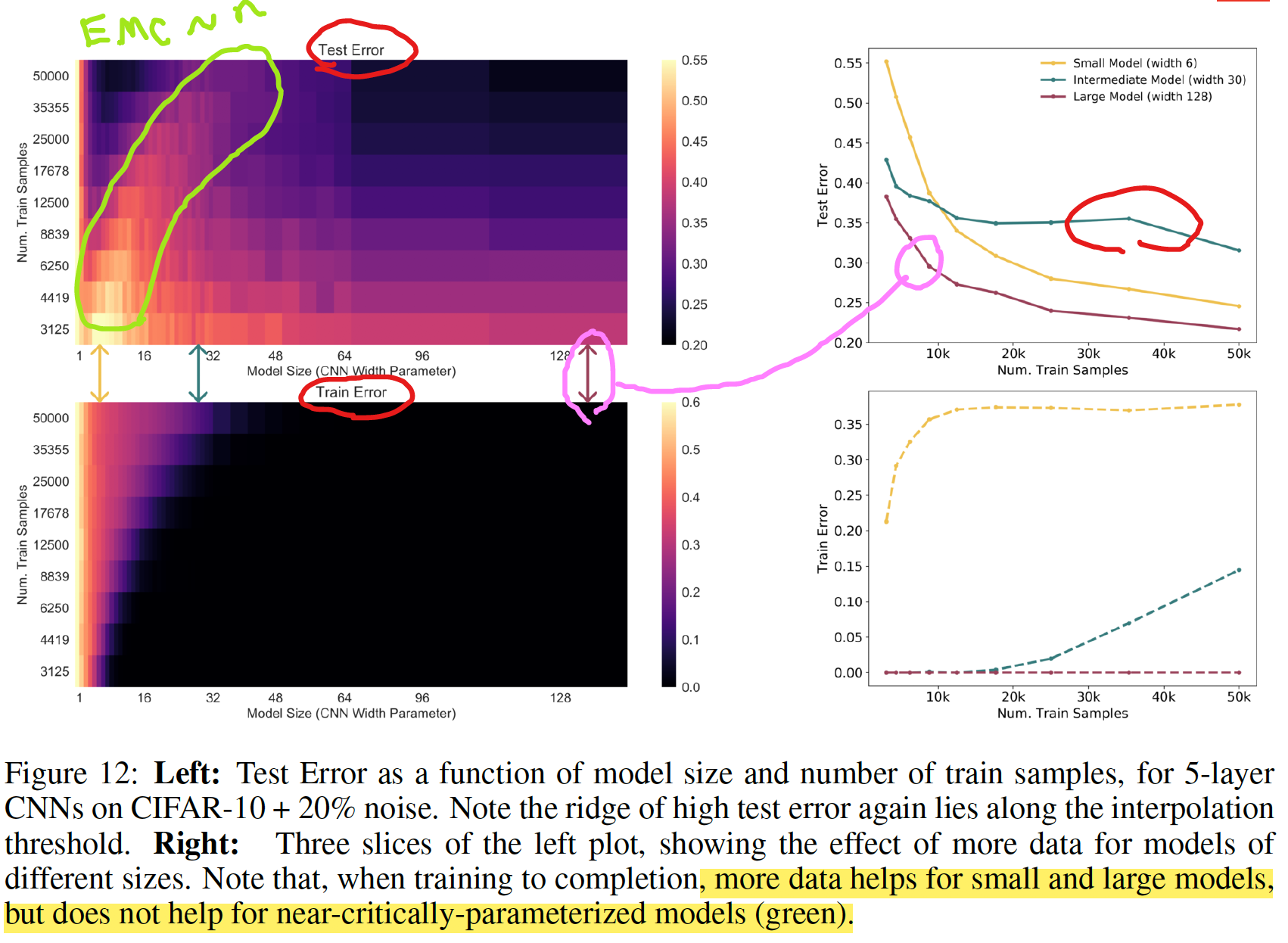
- 左図: モデルサイズとトレーニングサンプル数の2次元空間
- interpolation threshold 付近にピークがある
- 右図: 断面図
- サンプル数は、小さい/大きいモデルではパフォーマンス改善するが、中間のモデルでは改善しない
- より多くのデータがパフォーマンスを改善しない例は、DNN のみならず Linear Model においても確認されている (Appendix D を参照)
正則化の程度によって起こる double descent (Appendix E.2.2)

- epoch 数 vs 正則化項の係数 の空間で double descent のようなピークが観測されている
- W-like shape のような感じ?
- 論文では予備的な解析 (preliminary analysis) という位置づけで、深く調査はされていない
Early stopping を使っていても double descent は起こる
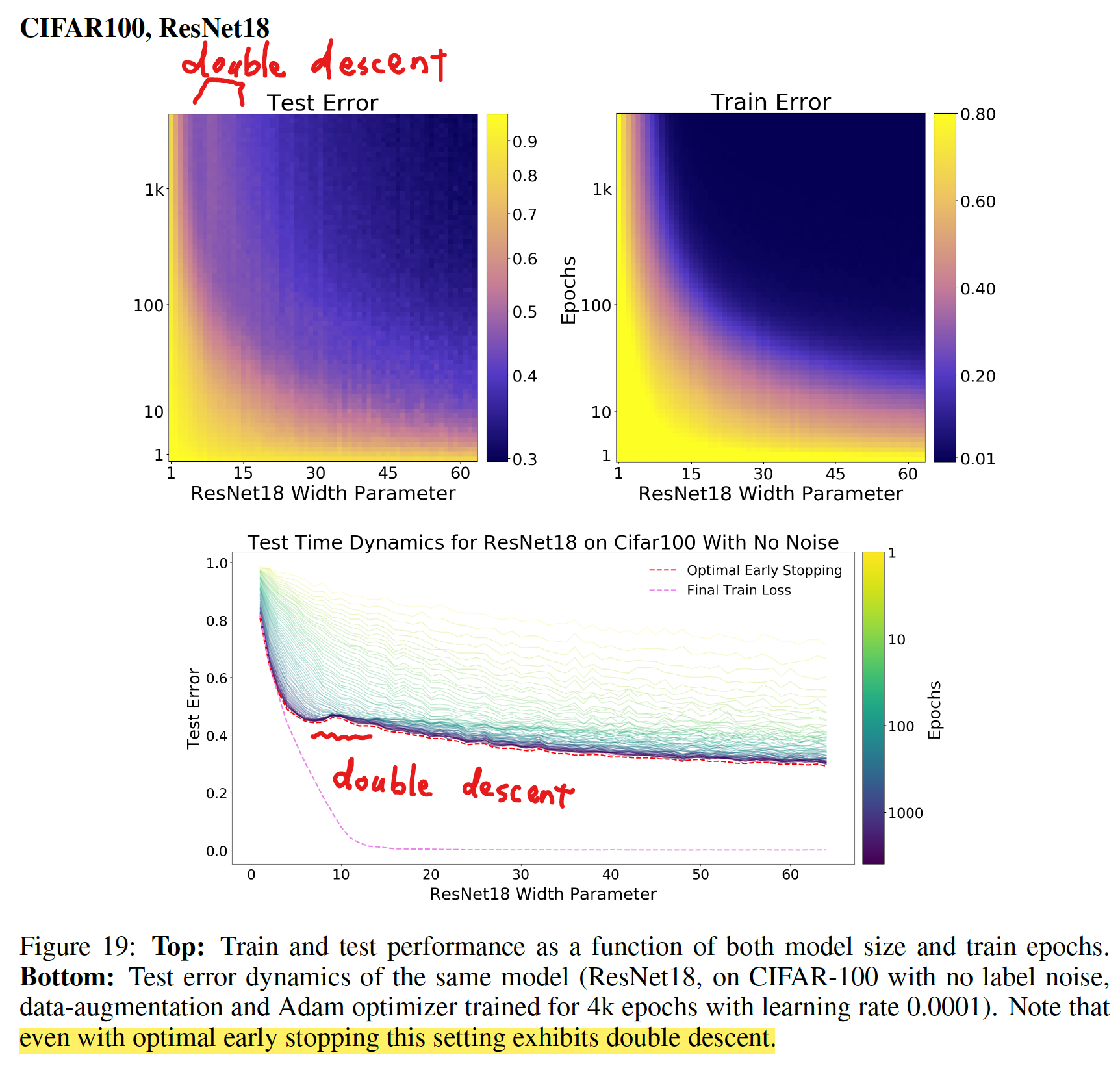
- early stopping を有効にしていても、double descent が起こる例が見られた
- ただし、ほとんどの場合、early stopping は double descent を抑制する
関連する先行研究
- Model-wise double descent は Belkin et al. (2018) によって、一般的な現象として、初めて提案された
- それ以前にも、似たような挙動は報告されていた: Opper (1995; 2001), Advani & Saxe (2017), Spigler et al. (2018), and Geiger et al. (2019b)
- その後、double descent に関する多くの研究が発表された
- 追跡可能な線形二乗回帰を使った理論解析: Belkin et al. (2019); Hastie et al. (2019); Bartlett et al. (2019); Muthukumar et al. (2019); Bibas et al. (2019); Mitra (2019); Mei & Montanari (2019)
- CNN on CIFAR-10 の Model-wise double descent: Geiger et al. (2019a)
Main contributions: 先行研究と比べて何がすごい?(新規性について)
- double-descent というアイデアを、パラメータ数のみならず EMC という指標を導入することで拡張し、epoch-wise double descent や sample non-monotonicity のような新しい観点を導いた
- 現代実用されている、幅広い DL の手法において、double-descent が起こることを示した
- double descent が robust phenomenon that occurs in a variety
of tasks, architectures, and optimization methods であることを示した - early stopping は、critically parameterized された models でのみ役立つことがわかった
結論
- under-parameterized regime (モデルの複雑さがサンプル数に比べて小さい領域) では、テストエラーはモデルの複雑さの関数として、U 字型の挙動を示す (the classical bias/variance tradeoff の挙動を示す)
- Over-parameterized regime (モデルの複雑さが十分に大きく zero training error もしくはそれに近い値を達成できる) では、モデルの複雑さをあげることでテストエラーを減少できる (“bigger models are better” の挙動を示す)
- Critically parameterized regime では、label noise や model の mis-specification が悪影響を与えやすく、古典的な過学習が起こりやすい
- EMC を導入することで、上記に説明を与えた
- “epoch-wise double descent" を初めて提案した
- より多くのデータを使うことがテストパフォーマンスに悪影響を与える場合があることを示した
議論
double descent が起こる理由
- interpolation threshold のモデルサイズは、トレーニングデータに有効的に fit するモデルは1つのみ
- このモデルはトレーニングデータセットのノイズ、またはモデルの誤設定に非常に敏感
- これは、このモデルがかろうじて、トレーニングセットに fit しているためで、すこしでもノイズが入ると、その global structure を壊してしまう
- 実際に、5 models の ensembling が、critical regime のテストエラーを低くすることが示されている (Figure 28 を参照)
- over-parameterized models では、トレーニングセットに fit する多くの interpolating models があり、SGD がノイズを “memorizes” (or “absorbs”) できるモデルを見つけることができる
- 上記の仮説は、線形モデルに関しては理論的な裏付けがあり (Mei & Montanari (2019)) 、Deep Learning においても拡張できると著者らは考えている
label noise が与える影響
- label noise を導入することで double descent が顕著になった
- 著者らは、これが label noise ではなく、model mis-specification に根本的な原因があると主張している
we view adding label noise as merely a proxy for making distributions
“harder”— i.e. increasing the amount of model mis-specification
残された課題
- Fully understanding the mechanisms behind model-wise double descent in deep neural networks remains an important open question
- We leave fully understanding the optimal early stopping behavior of double descent as an important open question for future work.
Discussion